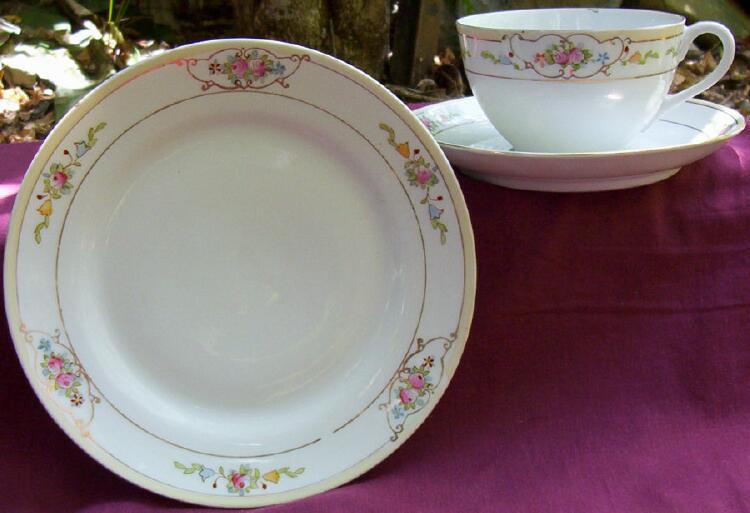

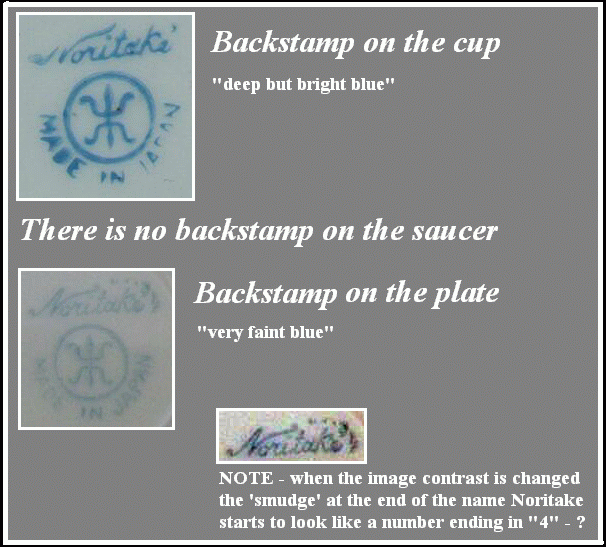
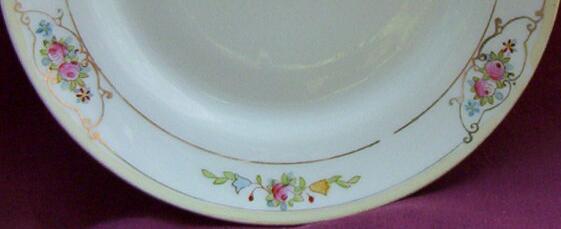
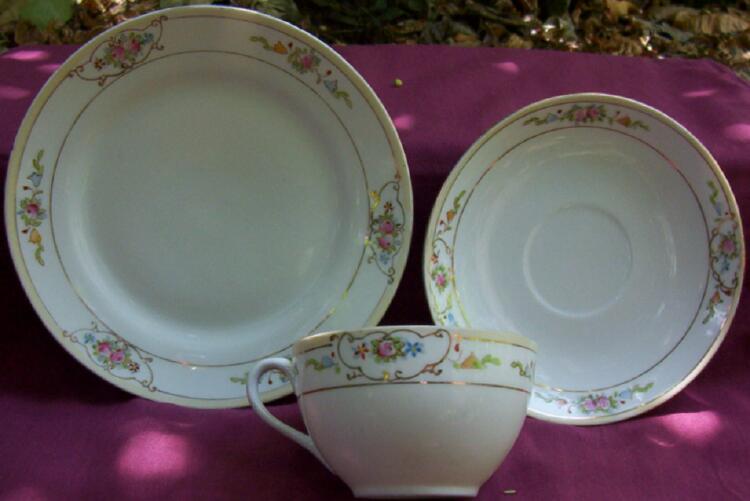
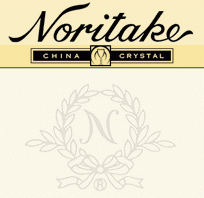

China Identification Help
Hello
I have attached three photos of a Noritake pattern I would
like identified
One of these is of the backstamps that are on the pieces
As well as the pattern name, is it possible to find out when the
set may have been made??
I hope the photos are satisfactory
I really appreciate your help
Thank you
Geoff
Thank you for contacting Replacements,
Ltd
The information you requested is shown below
Pattern - N2897 - by Noritake
Description - Cream Band, Floral Sprays
They were unable to identify the pattern, and gave it this
"book number"
A page has been created on the Replacements Web Site, and it can
be seen by CLICKING
HERE
The photo used is one of ours, and no prices have been listed

Hi Lisa
Thank you for your emails concerning our Noritake
"Pembroke" dinner set
Now the news - we have been converted - to Noritake!!
We are not collectors!! - and by no means rich!!
But we look around Ebay a bit and every now and again Sharon will
spot something she likes and we try to win the auction
For some time she has been saying - "I like some of this
old Noritake"
So, after seeing The
Collectors' Book on your site, we contacted Sue Ibbotson
and bought a copy which is now on it's way to us
So we are gunna become experts!!
I do not want to become a "pain-in-the-butt", but
Sharon has one other style in Noritake
Sharon's Mother lived in Adelaide, and she brought this back with
her after her Mum died a few years back
I have photos of the trio and the backstamp, but did not want
to send them to you until you gave the okay
I have no idea of the pattern name, and this is one of the things
I would like your help with
The backstamp looks like the blue one in the 1900's section of
your list which is marked "Registered 1908 - Variation 3"
If you give me the okay, I will send the photos on to you
Well, I better get ready to go out and buy another display cabinet
for all this Noritake that Sharon is going to buy!!
Regards, and appreciate your contact
Geoff
Dear Geoff
I am happy to recieve pics and see if I know the pattern
I spend a lot of time pattern ID'ing unnamed ones
And enjoy it ..particularly when I 'nail one'!!
So send away!!
I look forward to gettig the pics and will comment at length,
I imagine!!
Kind regards
Lisa
"I enjoy it ..particularly when I 'nail
one'..so send away"
I like that note above!!
The pics are attached
I can't give you too much detail - because I don't know too much!!
Sharon has three complete trios, and they came to her after the
death of her Mother
As I mentioned in my last note, the backstamp looks like the
blue one in the 1900's section of your list and is marked "Registered
1908 - Variation 3"
I thought it interesting that all three cups and the three plates
are marked, but none of the saucers
So I will now leave it up to you, "Detective" - hope
you can solve it!!
Bye
Geoff
Hi Geoff
Unfortunately I could not identify this pattern!!
All I can tell you is its pretty old
I think 1920's-30's from memory
It is a pretty pattern
So sorry I could not ID it
Regards
Lisa
Hi Lisa
I really appreciate the time you would have spent chasing this
up for us - THANKS!!
It is probably one of those very rare patterns that is worth thousands
of dollars!!
Well, that's our wish anyway!!
Have a nice day
Regards
Geoff

'Identifying a Pattern'
Hi, and can anyone help in identifying this pattern, as per the
attached photo
I have also included photos of the backstamps that are used on
these trios, of which we have three
Any and all info on this pattern, name, date, etc would be appreciated!!
Thanks, Geoff
Dear Geoff
Thank you for your question re: 'Identifying a Pattern'
Settings such as Tea Sets, Dinner Sets which are known as 'Utility
Ware' ie; wares which this particular backstamp (London Applied
for 1905, Registered 1908 mark) did not (to the best of my
knowledge) carry any of the following details:-
------------Pattern Name
------------Pattern Number
------------Nor did they bear a Pat Pending, Pat Applied For, Pat
Number
------------And they did not have Registered, Trade Marks, or Copyright
markings
The "London Blue 1905 Applied for Mark, and registered
1908", which your set/setting appears to have stamped on
the base, is known to have been used on and off until the onset
of the War in the Pacific, and also with several variations of
it being used throughout this long time line
Understanding when a pattern, shape or style of porcelain was
produced also helps you nail down as to when it was produced
Noritake, for example, spent many years in perfecting different
techniques, such as the production of Fine Bone Porcelain which
they achieved in 1933 when they patented the process for example
Also the successful production of the magic 8 inch or 20.5cm plate
which resulted in completion of the 93 piece dinner set in 1914
after 20 years of ‘bitter struggles’ with the pattern
name ‘Sedan’
Like all good companies they were into research and development,
and if you study your shapes and patterns and the function of
these items you see either on eBay or elsewhere, you will notice
that as you move into different time zones (generations) form
and function changed as well
In relation to the name of a pattern, it was not a common practice
in the early days, that is back in the early 1900’s, to place
a pattern name or a number on the base
In the USA for example, goods were sold via catalogue with drawings
in them and merchants would order from the catalogue and the goods
would arrive
In Australia and New Zealand however, samples were sent of the
actual items and the wholesaler’s representative then took
these to the merchants and orders were taken
Each Zone had it own way of taking orders
Sometimes a Merchant would give the salesman/representative a
pattern for a special order and a price was negotiated and these
goods were sold in a particular store
This was common in all Zones
A easy example is the pattern referred to as Azalea and Tree in
the Meadow, sold by the Larkin Company in via their Catalogues
However patterns which did not have a name, and there are thousands
of them produced, are now referred to as ‘Mystery Patterns’,
that is, ‘Patterns without a Name’
Geoff, this is what you have - "A Mystery Pattern"
If you read such books by learned researchers such as Joan Van
Pattern, Wojcechowski, Donahue, Murphy, Fisher, Brewer, Replacements
"Jewel of the Orient" and Alden, you will find that
they often refer to such patterns as Mystery Patterns
Designated Pattern Names for Identification Purposes
In order to make life a little easier for collectors, early Authors
such as Joan Van Pattern, Alden and others began assigning either
a number, a name and in some cases both, thus providing collectors
with a common point of reference to work from
Collectors could then consult with each other about patterns they
had
As a result, this has made collecting some patterns a lot easier
It is also not uncommon practice for individual collectors of
a pattern themselves to give a pattern a name, especially if it
does not have one on the back to identify it, or if no one has
given it a name to date
This for example was the case when I wrote the Collector book,
‘Noritake for Australia and New Zealand’
In Australia and New Zealand for example, many patterns we have
here with the AU1931, AU 1933, AUNZ 1933, J Design Mark have no
pattern name what so ever or number
Thus making identification extremely difficult
Whilst these goods when sold here (AUAN) originally would have
been given a number by the wholesaler, such records have been
lost or the reference information is not available for Pattern
Identification purposes
Fortunately some collectors who contributed to the book in the
form of photographs were kind enough to provide names which they
assigned a particular pattern they were collecting
Since these people were already collecting these patterns and
were comfortable with the names they had assigned the pattern/s,
and in addition were also consulting with other Collectors about
these pattern/s, it was only natural that I honour their wishes
Hence this is how many of the patterns collectors of AU and AUNZ
marked piece were named
Really, why try and reinvent a new name for something that collectors
had assigned a name to and were comfortable with?
It is clearly obvious as time progress’s and more patterns
are uncovered, new names will be given to AU and AUNZ marked pieces
With the establishment of the NCFAUNZ here in Australia and New
Zealand, the task of discovering, naming, recording new patterns,
along with the shapes that are available, has become a very important
mission
In doing so, we are re-building long lost information and putting
back together the jigsaw puzzle of what was available in a particular
pattern/series
What we are doing and have done, is certainly making life much
easier for all concerned
Examples include Castle on the Mount, Hounds and Huntsman, Merchant
of Venice (Gondola Scene), Man in the Field, Blossie, Isabeau
Rose, Hydrandrea Buttercup, Nasturtiums, Carnations, and so on
Why some pieces or sets were ‘Unmarked’
This part of your question relates to a very complicated period
in time for the world
The following is from my research I did whilst writing the book
"Noritake for Australia and New Zealand"
As a result of doing some background research, I was able to put
bits and pieces together and find old company records about china
importers and wholesalers
This is how I came across RM Hall Pty Ltd and AJ Chown Limited
It was not an uncommon practice for makers of ‘Imported Goods’
irrespective of where in the world this was, especially in the
early 1900’s, not to mark their goods with either a name
or even a country of origin
There are many reasons why this happened
Below are two examples of some information I found whilst researching
for the book that I would like to share with you
In some cases products may have been marked or unmarked depending
on what they were and what was their intended final port or point
of destination
Obviously there are other reasons I could speculate on, however
I am sure that would open a can of worms
|
Goods which carried a backmark incurred a higher
import levy especially if the goods were marked with a ‘Country
of Origin’, especially if the point of origin country was
not part of the Sterling Zone (Part of the British Empire) As a result, some manufacturers may not have marked their goods intentionally so that they could possibly avoid having to have a higher duty being paid on their goods, or there may have been the possibly that the manufacturer or importer was trying to evade ‘Anti - Dumping Laws’ The practice of ‘Dumping’ refers to goods, which were imported and then sold below the "normal value" of the goods This practice resulted in Australia and others developing Anti Dumping legislation in the early 1901’s to 1920’s |
|
In other cases imported goods may have found
their way into a Sterling Zone port which were known for not
carrying out careful inspections for ‘unmarked country of
origin of shipments’ In those cases these unmarked goods may have been placed on a cargo/passenger vessel and simply forwarded as part of a larger shipment to another destination with different paper work If this had of been the case for goods destined for the Australian market for example, such goods would have had an ad valorem (import duty) of only 15% to 20% depending on the type of goods being imported On the other hand, if these goods came directly from Japan, the duty payable was 45% It is important to note that different parts (Zones Countries of Origin) of the world were required to pay different levels of import duties or added tariffs were in some cases applied etc |
Whist this information is interesting, knowing
it gives you a greater insite into such aspect of imports
It is interesting to consider for example the production of goods,
where were they produced? the stability of the region at the time?
prejudices both social and political to a particular Zone at that
time, and other general events such as pre war activities, the
effects of wars, the great economic depression, protectionism,
nationalism, the rise of communism and fascism and the list goes
on
If you're into history, here is a little bit of information you
might find of some interest
This website - "History
Central - The 20th Century" - is a great resource
for a quick reference to what was generally happening in the world
during this time line
Starting at the time 1905 and ending at 1940:-
#01 - events leading up to the First World War in Europe
#02 - the emergence of communism, Chinese "Boxer Rebellion"
#03 - the events in Manchuria which lead to changes in Global
power and a significant shift in power in the Pacific region
#04 - the great tariff wars between the Americans, Japanese, Sterling
Zone and European countries which brought on policies of ‘economic
protectionism’ and ‘nationalism’
#05 - The instability caused by shortages in raw materials as
a result of the monumental impact of the (so called) machine age,
in particular the economic fall out because of ‘Over Production"
and the resulting ‘dumping of unmarked goods’ - this
resulted in the world wide Economic Depression of 1927 to 1939
and finally we move into the period of events that lead to the
onset of World War Two
It is not until around 1956 that the world began actively free
up restrictive trade practices with the end of what was called
the Sterling Zone countries
With all that said and done, even today we still see forms of
economic protectionism and nationalism demonstrated by such campaigns
as ‘BUY AUSTRALIAN MADE’
Anyway, getting back to your set - What I do know for sure
is this
Officially Noritake China was not sold via Noritake (aka) Nippon
Toki Kaisha Limited (nor any official agency) in Australia until
1917/18 when Mr S Nakagami opened the Morimura Brothers Trading
Company in Sydney, New South Wales, later changing the name to
Noritake China Company
It is known that buyers from large department stores and local
importers travelled to Japan (then known as Nippon) as well to
England and other places to acquire products
It is known that NTK Limited had a Agency in London pre 1918/19
and it is very possible that some sample goods were purchased
and imported into AU & NZ
One such importer and Wholesaler was Mr Raymond Hall, of RM Hall
Pty Ltd., from Victoria who started up his small venue in 1914
before the start of WW1
Another possibility of how your set/setting in its original format
may have come to Australia if it is a pre 1917/18 pattern/setting
was possibly through a Japanese Trading Company operating out
of Sydney, New South Wales
They may have imported some Noritake Product lines prior to the
arrival of Mr Nakagami, and sold these goods from their wholesale
business or small retail outlets
Your set or setting
may have been one of these very early Mystery Patterns
We will never know
There are no records left from this period to confirm where they
came from, neither here in Australia nor back in Japan
However from my own
perspective and I may be wrong, but the shape of the cup suggests
that it was a product line produced in great numbers over a long
time line, possibly as early as 1908/10 through to as late as
1928
The style and design, Geoff, is commonly referred to as Art Nouveau
I say this because the pattern fits the classical style often
defined by Art Nouveau, which was ‘graceful in appearance’,
with details that included cursive lines often having interlaced
patterns such as flowers, plants or both, animal motifs all which
were inspired by the tranquillity and grace of nature
Geoff, if you look closely at the pattern, it shows several of
the typical tell tail classical Art Nouveau characters, garlands
of flowers, leaves bordered by cursive lines giving the pattern
a graceful ornamental appearance
The colours in use were typical in the Art Nouveau period, such
as the soft creams, blues, pinks and greens and the subtle application
of gold accents
The Art Nouveau style is one I suppose you could say is ‘ornamental’
ie; ‘serving a purpose of decoration or beauty rather than
usefulness’, established to protest against the sterile realism
or unnatural artefacts produced by industrialism and mechanisation
Lastly, the reference to the Number 4? mentioned on the backstamp
photo
I believe what you think is a number is more likely a smudge from
when the stamp was applied to the porcelain
I am positive it was not marked with a number
Hope this little bit of information has been of some assistance
to you and other readers
I hope I have not missed anything
If you need further clarification I will try and help
All the best and thank you for sharing
Sincerely, Karry-leeanne Fisher
The Patron/Manager - MSNGROUPS - Noritake Collectors Forum
What can I say about that
reply?
Except FANTASTIC!!
Hi, Karry-leeanne Fisher
THANK YOU for taking the time to type out that very comprehensive
reply
Every bit of info that I could possibly want!!
I did purchase your book, 'Noritake for Australia and New Zealand',
back in October 2006
Going to start to use it more now as Sharon and I pick up more
pieces of Noritake!!
We really appreciate your assistance
Regards
Geoff and Sharon Roneberg
Cairns North Queensland